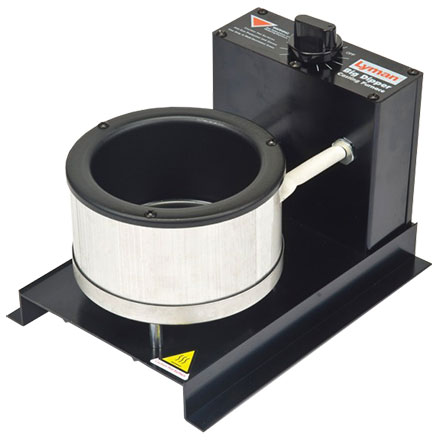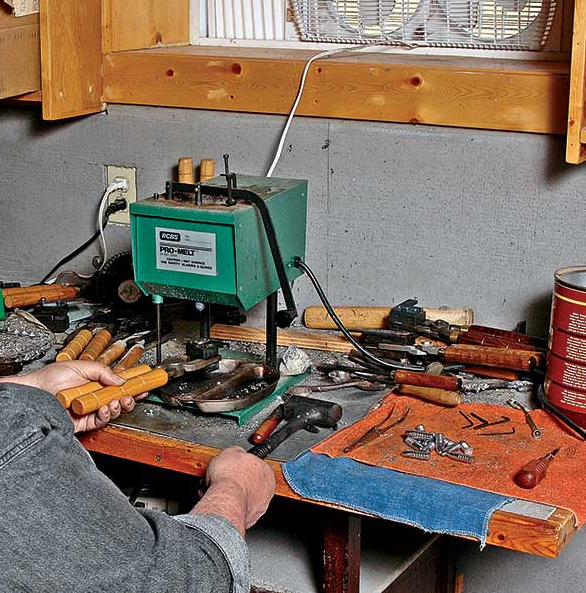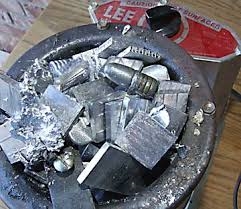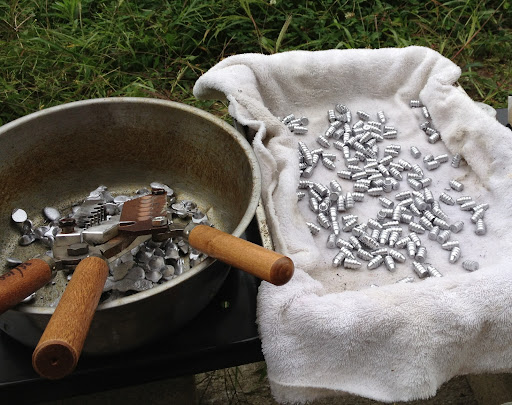I was quite young, around eleven or twelve years old, when my country cousin introduced me to the concept of melting lead to make bullets for his .38 Special and .41 Magnum revolvers. I call him my country cousin because he lived on a farm and I lived in town. He was a year older than me and had guns and a horse. We were like brothers in many ways and always had projects going on. To make ammo for his for his guns we gathered all the brass from our shooting adventures and collected lead in the form of wheel weights from junk cars and used type from the town newspaper. This was all so many years ago the details escape me. It wasn’t a project we continued from year to year because we got into cars and girls and made enough money to buy our ammo ready-made. Still, it gave me an awareness of how one could make their own bullets.
Now, sixty-five years later, I reload but haven’t cast my own bullets since those early days on my cousin’s farm. But you know what? I’ve got time on my hands, a nice little workshop and a couple of grandsons who are interested in learning reloading stuff. Let’s see what it’s going to take to get into the business of casting my own bullets.
After years of reloading my own ammunition for target shooting and hunting, I figured it was time to learn about casting bullets. It wasn’t just about saving money—it was about learning a new set of skills I could pass along. I picked a corner of my work bench to transform into a bullet casting workshop.
Gathering Tools and Materials
I began by assembling the essentials. Since I shoot more 9mm than any other caliber, I chose a Lyman Single Cavity Pistol Bullet Mold #356637 9mm 125 Grain Hollow Point, a Lyman # 2786749 Top Punch #637 and Lyman Double & Single Cavity Bullet Mold Handles for handling bullet casting. Next, I set up a small electric furnace to melt the lead.

Big Dipper Electric Casting Furnance
Speaking of lead, I thought finding clean, high-quality lead for my bullets might be a challenge. Before setting off to find a Discount Tire store, I took a look online and found multiple sources selling lead ingots for use as fishing lures or casting bullets including Amazon and Walmart. Easy solution.
I laid out a pair of thick gloves, safety glasses and a heavy-duty respirator mask. Lead fumes are no joke, and I wasn’t interested in breathing them in. I found a respirator mask in the Uline catalog. I put a small ventilation fan near the window over the workbench to help keep the air clear. Additional accessories included ladles, flux to clean the lead and a pile of ingot molds to pour any excess lead into for later use.
Organizing the Space
The workbench was quickly transformed into an organized, functional space. The furnace took center stage, and I bolted it down so it wouldn’t tip over. I mounted a small rack for tools, keeping everything within arm’s reach—ladles, molds and a pair of tongs.
My reloading presses, powder scales, and trays for cases and bullets were all set up at the other end of the workbench. This was the second half of the operation. After casting the bullets, they would be sized, lubed and pressed into the waiting brass casings.

The First Pour
With everything in place, I turned on the furnace and watched the lead inside begin to melt. After what felt like hours, but was really only twenty minutes, the lead had turned into a smooth, silvery liquid. I carefully scooped out the dross—impurities that floated on the surface—with a ladle. I sprinkled in a pinch of flux to further purify the lead, stirring gently. The molten metal shimmered like mercury. Placing the mold beneath the furnace’s spout, and with a steady hand, I pulled the lever. A stream of molten lead flowed into the mold, filling each cavity with a hiss. I waited a few seconds, then opened the mold to reveal my very first cast bullets. They were rough, still hot, but undeniably beautiful.


The Process Becomes Routine
Over the next few hours, I fell into a rhythm. Melt, pour, open the mold, drop the bullets onto a towel to cool. It was a slow, methodical process, but there was something deeply satisfying about it. With each batch, the bullets came out cleaner, smoother, and more uniform. When the furnace needed a refill, I melted down more wheel weights and excess lead. The discarded impurities were skimmed away, leaving behind only clean metal for the next pour.
A small pile of bullets lay ready for the next step: sizing and lubing. This wasn’t just about making bullets—it was about mastering a skill. Setting up shop to cast bullets has been more than just a hobby. It is a new way to connect with the craft of shooting, a deeper understanding of the process that has fueled my passion for years.








